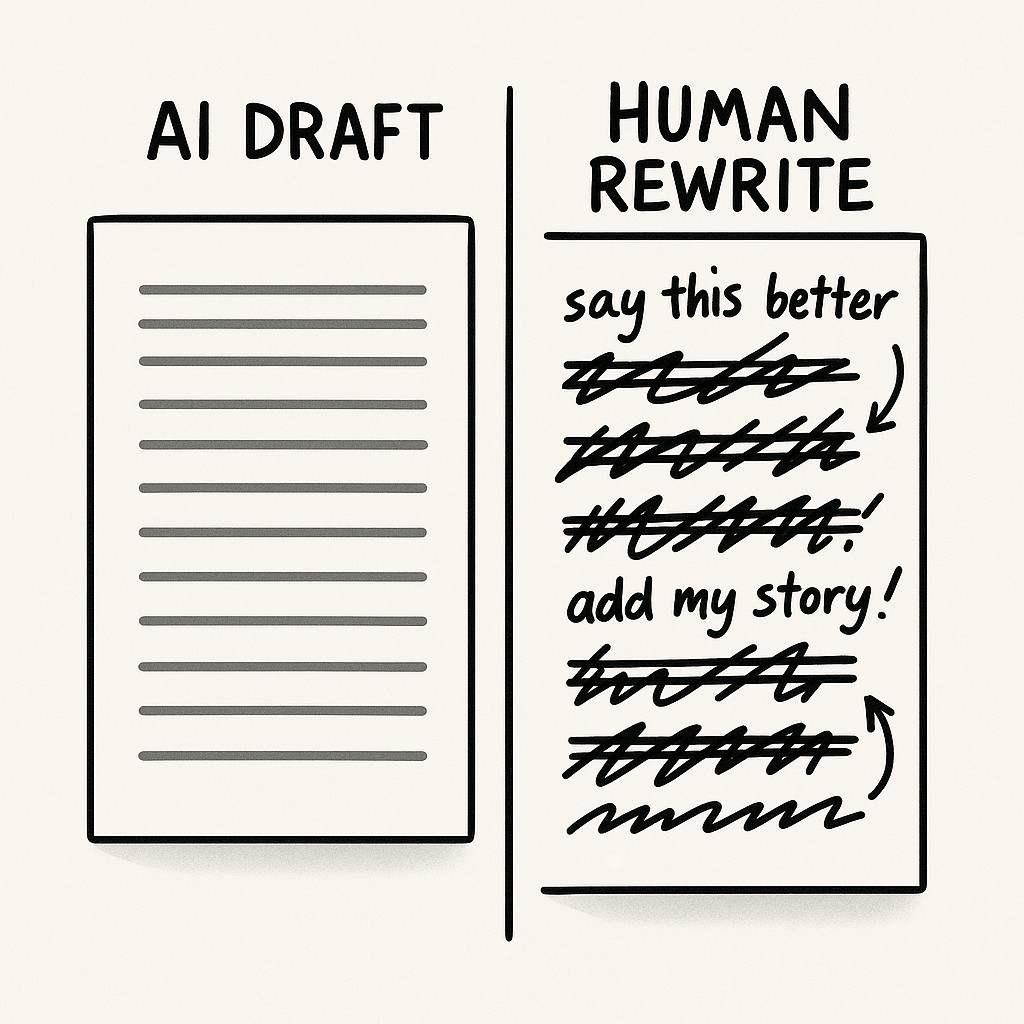Maintain Authentic Voice with AI: A Practical Workflow That Amplifies Clarity
Maintain Authentic Voice with AI: A Practical Workflow That Amplifies Clarity

AI Posts Landed Flat. Voice Made the Difference.
The first time I tried to maintain authentic voice with AI, I let AI take the wheel and used it to crank out trend-driven blog posts. I’d feed a few topics into ChatGPT, get back a thousand words about “top AI tools for developers” or “how LLMs transform workflows,” dress it up, and hit publish. It felt efficient. The outputs looked good enough if you skimmed them.
But every post felt like déjà vu, the average of the internet, a bland imitation of the posts already clogging my feed. I kept thinking, “This is what everyone else is doing—why would anyone care about my version?” After a few rounds, it hit me. I wasn’t adding anything of myself. None of it sounded or felt like me. It was competent, but so forgettable that even I stopped halfway through rereading it.

So I stopped chasing one-prompt, trend-chasing content. I know. I’ve made that kind of content before. It worked but was the average of the internet, so I stopped.
Once I dropped the format and started writing shorter, more personal LinkedIn posts, things shifted. Instead of chasing trends, I talked about what actually happened at work that week, or a weird thing AI did with my rough draft. The traction and trust shot up, not because the writing was perfect, but because it sounded like a person figuring things out. Turned out, the real missing variable wasn’t the AI. It was me. The ideas, the half-formed opinions, the small work stories—that’s the raw material AI can’t manufacture. What if I write like I speak, and AI just helps me say it better?
That’s the real work. Lead with your intention and your voice, then use AI to tighten things up. AI clarifies. It doesn’t communicate. People think AI is doing the communicating.
If you stick with me, I’ll show you a workflow for RFCs, design docs, and developer blogs that keeps your voice real but amps up the signal you care about.
Authenticity Comes First—AI Can’t Invent Your Voice
We’ve digitized nearly every creative field, music, film, design, and each time, it’s unlocked more access. More voices. More stories. But with writing, the reaction feels oddly defensive. There’s this deep worry that if we let the machines in, the real stuff, our individuality, gets erased. Maybe that’s because writing’s always been a shortcut to who we are. It’s closer to your brain than a synthesizer or a Photoshop filter. Still, the pattern holds. Tech gives more people tools to express, not fewer. What matters is what you do with that access.
But here’s why AI, as it actually exists, can’t shortcut the messy reality of communicating something original. LLMs are designed to predict plausible next text. They’re experts at structure and pattern. Yet at the midpoint, a model has learned half its total ability to predict the next word, making its output all about statistical plausibility, not personal intent. It’s like they’re auto-completing the internet, not reaching into your head.
This isn’t even a new anxiety. Back in ancient Greece, Plato argued that writing itself would erode memory and understanding, that relying on external tools would make us lazy thinkers. But tools rarely erase the human element. They just move the work. Instead of carving thoughts into stone or memorizing speeches, people learned to clarify ideas on the page, and the best voices always found a way to stand out. Every era brings its version of this panic. And yet, creativity adapts, then expands.
So let’s reframe. Human-guided AI writing is the real value—amplification, not authorship. It’s most useful when guided by your strong voice and intent. Your brain sets the direction. The model sharpens the path. Not as an author. As a lens.
Make It Yours—A Concrete Workflow to Maintain Authentic Voice with AI
Step one is simple, but most people skip it. Draft in your own words, as fast as you can. Don’t fuss about grammar or order. Don’t even worry if the sentences are half-finished. Just pour out your actual thoughts—including that nagging example in your head and every doubt you have—onto the page. It’s a brain-dump. The only rule? Capture your own voice, even if it’s a little messy. Some of my best lines come out half-baked and only make sense after I get them down, so don’t stress about polish yet.
Once you’ve got your raw draft, that’s when AI becomes useful. Ask it to clarify—literally. I’ll paste my messy paragraphs and tell the model to organize them into logical sections, surface counterpoints I skipped, and help me find specific examples from my own notes or repos (don’t let it invent new ones, trust your source material). The technical move here is straightforward.
Prompt AI like you’d prompt a human editor. “What points am I missing?” “Where does this feel unsupported?” I’ve found the magic happens not when I let AI write, but when I use it to reflect and question. If you’ve ever felt stuck playing whack-a-mole with an outline, this shortcut is a lifesaver. It’s not perfect, but it turns a tangle of ideas into something someone else could actually follow.
Quick tangent—about five months ago I found a half-written README for an internal tool, intentionally stopped after three bullet points because I couldn’t make the language sound like ours. I remember being halfway through a sentence and realizing, I was copying from another repo’s doc, not actually explaining what made ours different. I put it down, grabbed a coffee, and when I came back, I wrote it talking out loud—just saying what I’d say if someone asked in person. Not only did it finish itself, but the next version got picked up directly in our onboarding guide. The doc wasn’t pretty, but everyone said they understood what it was for, finally. Funny how just abandoning polish can let something breathe.
Back to you. As you refine, keep your intent right in front of you. Write a literal north star at the top of your doc. “What am I actually trying to say, to whom, and why right now?” Check every suggestion—especially anything AI adds—against that. If it muddies your original intent, cut it. The point is clarity, not bloat.
Last move: maintain authentic voice with AI by doing a voice check before you hit publish. Read it out loud. If it sounds like you, you’re done, even if it’s not perfect. If you stumble, or it reads like someone else, rewrite the parts that stick out, even in dry artifacts like RFCs or PR descriptions. Reading your post out loud makes every sentence stand alone, which is the key to editing for true clarity (Excelsior OWL). It works just as well for design docs as public blogs. The trick isn’t fancy language. It’s making sure you’re still at the center, regardless of where it ends up.
Clearing the Biggest Objections
Let’s talk about time. Most people think adding AI to their workflow means more friction, not less. But here’s the shift. Split the job into parts. First, spend twenty minutes dumping thoughts—a true spill, zero edits. Next, ten minutes of AI structuring. For AI writing clarity, let the model organize, sequence, and surface what you missed. Last, ten minutes reading it with your own voice in mind. Editing is easier when the big stuff is sorted. You’ll find you move faster when you stop mixing thinking and refining. Framing cuts down back-and-forth, which stabilizes outputs and saves cycles.
Messy drafts? I used to see them as evidence I didn’t know what I was doing. Now I treat them as a good sign. Mess means the ideas are mine. Even when I write without AI, there’s translation going on. AI just makes the bridge a little faster. I’m not outsourcing. I’m clarifying.
Let’s address the worry about voice dilution and ethics, especially after Medium’s decision to tag posts with AI-attribution. The backlash didn’t target helpful workflows. It went after the sludge, those generic, AI-pumped articles with no clear author. When your workflow keeps authorship at the center, what you make is still yours. The point isn’t hiding AI. It’s keeping your intent up front and human.
So here’s how I keep voice with AI clean. Be clear about your process if the setting calls for it, cite real sources not just whatever the AI comes up with, and always keep the final edit for yourself. You own the threshold. If it doesn’t sound like you, don’t ship it. Simple rule. The signal is trust.
There’s always the risk I’ll slip into old habits and let convenience win out over voice. I try to catch it, but sometimes a post sneaks by that still sounds a little too much like everyone else. I haven’t found a perfect fix for that. Maybe that’s just part of using these tools.
Actionable Patterns for Preserving Voice and Building Trust
Authentic writing with AI means your words sound like they came from you, not from a machine. My go-to prompt is simple and direct. “Here’s my raw draft. Keep my tone. Tighten structure. Surface contradictions and concrete examples from my notes, but don’t add new claims.” When you set those boundaries, the output is more you, less internet average.
Let’s put this to work. In technical writing with AI, say you have a rambling section in a design doc explaining a migration plan—a jumble of pros, cons, warnings, half-formed decisions. Drop it into the model and ask for a three-part structure: problem, tradeoffs, decision. Then, take the organized output and put your language back in—idioms, shortcuts, and real examples you’ve actually hit in production. Don’t let SEO drive you. Just aim for clarity anyone on your team could scan fast.
If you want to build that muscle, share small pieces publicly before tackling something big. I use LinkedIn for trial runs—posting a snippet one afternoon, seeing which lines spark reactions, then folding what worked into longer docs. Quick feedback in the wild beats endless drafting alone.
Draft in your own voice, then let AI tighten structure—spin up a post, doc, or RFC in minutes with prompts that keep your intent clear and your message sharp.
We’ve guarded writing like sacred ground, almost religious about keeping it undiluted. But when guided by clear intention, AI doesn’t replace the communicator. It amplifies them. It’s expanding who gets to feel heard.
Enjoyed this post? For more insights on engineering leadership, mindful productivity, and navigating the modern workday, follow me on LinkedIn to stay inspired and join the conversation.
